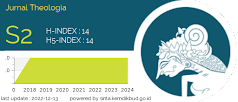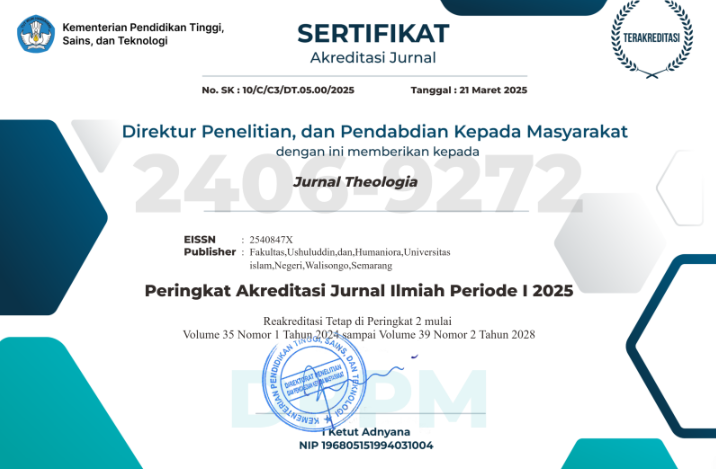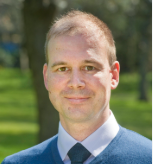Negotiation Between Patuntung and Islam in Kajang, South Sulawesi, Indonesia
DOI:
https://doi.org/10.21580/teo.2023.34.2.17961Keywords:
Ammatoa indigenous people, Islam and Patuntung, negotiation, traditional religion, Sallang's hybrid realityAbstract
This research examines the relationship between Islam as a world religion and Patuntung as a traditional religion adhered to by the Ammatoa indigenous community in Kajang, South Sulawesi. The relationship between these two religions is not only oppositional or harmonious but also dynamic and negotiating. This research uses a qualitative method with a 'New Ethnography' approach, which pays attention to three aspects: self-reflection, polyvocality, and testimony. The findings of this research show that the meeting between Islam and Patuntung produces a hybrid reality, namely Sallang, which is basically a different Islam and another Patuntung. Sallang is a new reality that emerged from the meeting between Islam and Patuntung. This is clearly seen from Ammatoa's belief that the Koran is 40 juz, 10 juz revealed in Kajang, and 30 juz revealed in Mecca. This research provides a new contribution to the study of the relationship between world religions and indigenous religions, especially in Indonesia.Downloads
References
Adair, Wendi L., and Jeanne M. Brett. “The Negotiation Dance: Time, Culture, and Behavioral Sequences in Negotiation.” Organization Science 16, No. 1 (2005): 33–51. https://doi.org/10.1287/orsc.1040.0102.
Ahmad, A.K. “Komunitas Ammatoa Di Kajang Bulukumba (Studi Tentang Peranan Kepercayaan Terhadap Pelestarian Lingkungan Hidup).” Universitas Hasanuddin, 1991.
Alim, Mas Katu. Kearifan Manusia Kajang. 1st ed. Makassar: Pustaka Refleksi, 2005.
Amin, Sitti Jamilah. “Talassa Kamase-Mase Dan Zuhud: Titik Temu Kedekatan Pada Tuhan Dalam Bingkai Pasang Ri Kajang Dan Ilmu Tasawuf.” KURIOSITAS: Media Komunikasi Sosial Dan Keagamaan 12, no. 1 (2020): 61–75. https://doi.org/10.35905/kur.v12i1.1199.
Aris, M. “Temui Ammatoa, Edy Manaf Kenakan Jas Khusus Dari Kahar Muslim.” Panrita.News. 2020. https://panrita.news/2020/08/13/temui-ammatoa-edy-manaf-kenakan-jas-khusus-dari-kahar-muslim/.
Bhabha, H. The Location of Culture. London & New York: Routledge, 1994.
Budiman, A. “Ilmu Sosial Indonesia Ahistoris.” Prisma. Jakarta, 1983.
Canse, A.A. “The Patuntung in the Mountain of Kajang.” KITLV, no. C. 170 (1931).
Djafar, R. “Puto Sambeang, Gelar Kehormatan IYL Dari Ammatoa Kajang.” SulselEkspres. September 30, 2017. https://sulselekspres.com/puto-sambeang-gelar-kehormatan-iyl-dari-ammatoa-kajang/.
Fanon, F. Black Skin, White Masks. 1st ed. London: Pluto Press, 1986.
Farid, Syed Alatas. Diskursus Alternatif Dalam Ilmu Sosial Asia: Tanggapan Terhadap Eurosentrisme. Terj. Bandung: Mizan, 2010.
Fink, Bruce. The Lacanian Subject: Between Language and Jouissance. Princeton: Princeton University Press, 1997.
Gibson, T. Kekuasaan Raja, Syeikh Dan Ambtenar: Pengetahuan Simbolik & Kekuasaan Tradisional Makasar 1300-2000. Terj. Makassar: Inninawa, 2009.
Gouda, F. Dutch Culture Overseas: Colonial Practice in the Netherlands Indies, 1900-1942. 4th ed. Amsterdam: Amsterdam University Press, 1996.
Hijjang, P., M. Basir, and A. Ismail. “Indigenous People’s Environmental Conservation System: Case Study of Kajang Society, Indonesia.” IOP Conference Series: Earth and Environmental Science 343, no. 1 (2019). https://doi.org/10.1088/1755-1315/343/1/012090.
Hooks, B. “Marginality as Site of Resistance.” In Out There: Marginalization and Contemporary Cultures, edited by at al. Ferguson, Russell, 341–43, 1990.
Huddrant, D. Homi K. Bhabha. Creating Postcolonial Literature: African Writers and British Publishers. 1st ed. London & New York: Routledge, 2006. https://doi.org/10.1057/9781137328380.
Ismail, F. “Agama, Kepercayaan Dan KTP.” Sindo. 2017. https://nasional.sindonews.com/berita/1257816/18/agama-kepercayaan-dan-ktp.
Kahn, J.S. “Culturalising the Indonesian Uplands.” In Transforming the Indonesian Uplands, edited by T.M. Li, 2nd ed., 81–106. Amsterdam: the Taylor & Francis e-Library, 2005. https://doi.org/10.4324/9780203986127.
Katu, Samiang. “Local Islam in Indonesia : Religion ‘ Patuntung ’ in Kajang.” Journal of Islamic Civilization in Southeast Asia (JICSA ) 3, no. 2 (2014): 1–19.
———. Pasang Ri Kajang: Kajian Tentang Akomodasi Islam Dengan Budaya Lokal Di Sulawesi Selatan. Makassar: Pusat Pengkajian Islam dan Masyarakat, 2000.
Khu, Stanley. “Michael Taussiq: Fetis, Mimisis Dan Keliyanan.” In Pengantar Tokoh-Tokoh Antropologi Marxis, edited by Dede Mulayanto and Stanley Khu, 137–57. Tangerang Selatan: Marjin Kiri, 2014.
Li, Tania Murray. “Marginality, Power and Poduction: Analysing Upland Transformations.” In Transforming the Indonesian Uplands, edited by Tania Muray Li, 1st ed., 1–46. Amsterdam: Harwood Academic Publishers, 2005.
Maarif, S. “Ammatoan Indigenous Religion and Forest Conservation.” Worldviews 19, no. 2 (2015): 144–60. https://doi.org/10.1163/15685357-0190200.
Maarif, Samsul. “Meninjau Ulang Definisi Agama, Agama Dunia, Dan Agama Leluhur.” In Kebebasan, Toleransi Dan Terorisme: Riset Dan Kebijakan Agama Di Inonesia, 13–47. Jakarta: Yayasan Paramadina, 2017.
———. Pasang Surut Rekognisi Agama Leluhur Dalam Politik Agama Di Indonesia. 1st ed. Yogyakarta: Center for Religious and Cross-Cultural Studies (CRCS), 2017.
———. “The Encounter between Indigenous Religions, World Religions and Modernity.” Journal of Islamic Civilization in Southeast Asia (JICSA ) 1, no. 1 (2012): 1–11. https://doi.org/https://doi.org/10.24252/jicsa.v1i1.711.
Madiong, B., A. Rahman, S. Bahri, Almusawir, and A. Fahri. “Strengthening Traditional Institutions ‘Pabbatang’ As An Alternative Conflict Resolution In The Karampuang Community In Sinjai Regency, South Sulawesi Province,Indonesia.” Res Militaris 13, no. 3 (2023): 1194–1202. https://resmilitaris.net/menu-script/index.php/resmilitaris/article/view/3525.
Malliongi, Muhammad Takbir. “Kebahagiaan Menurut Masyarakat Kajang Di Sulawesi Selatan.” In Nyanyian Sunyi Dari Pelosok Negeri, edited by Muhammad Soehadha, Maulana Rezza, and Siti Khuzaimah, 1st ed. Yogyakarta: aboratorium Religi dan Budaya Lokal (LABeL) UIN Sunan Kalijaga, 2016.
May, Simon Cabulae. “Compromise in Negotiation.” Nomos 59, no. 1 (2018): 150–66. https://www.jstor.org/stable/10.2307/26786038.
Pelenkahu, R.A., et.al. “Dialek Kondjo Di Sulawesi Selatan.” Udjung Pandang, 1971.
Renre, A. Patuntung Di Kecamatan Sinjai Barat. Makassar: Alauddin University Press, 2012.
Rössler, Martin. “Striving for Modesty; Fundamentals of the Religion and Social Organization of the Makassarese Patuntung.” Bijdragen Tot de Taal-, Land- En Volkenkunde / Journal of the Humanities and Social Sciences of Southeast Asia 146, no. 2 (1990): 289–324. https://doi.org/10.1163/22134379-90003220.
Said, Edward W. Orientalism. 2nd ed. New York: Vintage Books, 1979. https://doi.org/10.2307/2536347.
Salle, Kaimuddin. “Kebijakan Lingkungan Menurut Pasang (Sebuah Kajian Hukum Lingkungan Pada Masyarakat Ammatoa Kajang Kabupaten Daerah Tingkat II Bulukumba).” Universitas Hasanuddin, 1999.
Sambu, Abdul Haris. Sejarah Kajang. Makassar: Lentera Kresindo, 2016.
Sangadji, A. “Kritik Terhadap Gerakan Masyarakat Adat Di Indonesia.” In Adat Dalam Politik Indonesia, edited by J.S. Davidson, D. Henley, and S. Moniaga, Terj., 347–66. Jakarta: Yayasan Obor Indonesia & KITLV-Jakarta, 2010.
Scott, James C. “Everyday Forms of Resistance.” The Copenhagen Journal of Asian Studies 4, no. (1989): 4–89. https://doi.org/10.22439/cjas.v4i1.1765.
Smith, Tuhiwai Smith. Decolonizing Methodologies: Research and Indigenous Peoples. Second Edi. London & New York: Zed Books, 2012. https://doi.org/10.4324/9781315700779-29.
Syamsurijal, Syamsurijal. “Islam Patuntung: Temu-Tengkar Islam Dan Tradisi Lokal Di Tanah Toa Kajang.” Al-Qalam 20, no. 2 (2014): 171–78. https://doi.org/10.31969/alq.v20i2.197.
Sylviah, and M. Muslim. “Mengilhami Kreativitas Keberagamaan Masyarakat Melalui Perjumpaan Islam Dan Patuntung Di Tanah Toa Kajang.” Jurnal Khazanah Keagamaan 8, no. 2 (2020): 145–64. https://doi.org/https://doi.org/10.31969/pusaka.v8i2.414.
Thompson, E.P. Costums in Common: Studies in Traditional Popular Culture. 2nd ed. London & New York: The New Press, 1993.
Tsing, Anna L. Di Bawah Bayang-Bayang Ratu Intan: Proses Marjinalisasi Pada Masyarakat Terasing. Jakarta: Yayasan Obor Indonesia, 1998.
Usop, K.M.A. “Pasang Ri Kajang (Kajian Sistem Nilai Di ‘Benteng Hitam’ Amma Toa).” Ujung Pandang, 1978.
William Cummings. Making Blood White: Historical Transformations in Early Modern Makassar. Honolulu: University of Hawai’i Press, 2002.




















